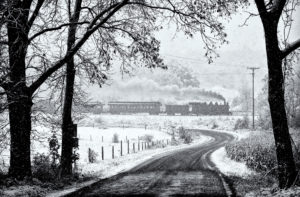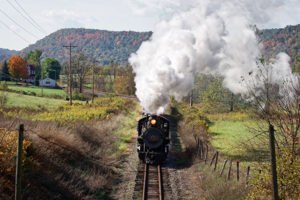About the Railroad

Also visit the EBT Foundation’s site at eastbroadtop.com
Nestled in the hills of south central Pennsylvania is a railroad that time has left behind. When you visit the East Broad Top today, you will find a sleeping railroad, its infrastructure largely intact.
Largely unchanged since common-carrier operations ceased over a half-century ago, the East Broad Top Railroad is a slice of history that, unlike many other small lines, was never torn up.
Now the rails rust quietly in the forest, but once they saw hard-working steam engines hauling long trains of coal. At the East Broad Top’s Rockhill headquarters is a complete shops complex built in the 19th century and fully equipped to maintain the railroad, its locomotives and rolling stock. In this time capsule of American industrial history, you can still find work that was started over a half century ago and that waits patiently for skilled hands to return to the lathes, drills and forges.
It is no wonder that the late William Withun, long-time transportation curator at the Smithsonian National Museum of American History, described the East Broad Top as an “incomparable national treasure. . . . Nowhere in North America does such a complete and original industrial historic site exist.” Similarly, the National Park Service has designated the East Broad Top as a National Historic Landmark and documented many of its notable features via the Historic American Engineering Record.

The East Broad Top was originally chartered in 1856. The main line was opened from Mount Union to Rockhill in August of 1873, and extended to Robertsdale by November, 1874. With a main line 33 miles long and (at its peak) over 70 total miles of track, the EBT ran for over 80 years, hauling coal, pig iron, iron ore, ganister rock (used in the manufacturing of specialty refractory brick), lumber, general merchandise, and passengers through the mountains of south central Pennsylvania.
The railroad was generally profitable from the late 1800s up to the 1940s, affording it the opportunity of upgrading its infrastructure to a much greater degree than did other narrow gauge railroads. Development of a full set of shops at Rockhill allowed the railroad to embark on a program of building almost three hundred steel cars for hauling the semi-bituminous coal from the mines on the east side of Broad Top Mountain to the interchange with the Pennsylvania Railroad at Mount Union. Further improvements included high-powered, modern steam locomotives and a modern coal-cleaning plant at Mount Union.
Near the end of operations, coal accounted for 90% of the railroad’s revenues. Alas, the bottom dropped out of the coal market in the early 1950s as customers converted to oil and gas, and the railroad’s revenues steadily declined. Passenger service ended on the EBT in 1954 with the closing of the last Rockhill Coal Company underground mine south of Robertsdale. The line closed as a common carrier on April 14, 1956, and was sold to Kovalchick Salvage Corporation of Indiana, PA.

But something miraculous happened. The railroad was not scrapped. Instead, it sat dormant for four years until the Kovalchick family began tourist operations in conjunction with Orbisonia and Rockhill’s bicentennial celebrations in 1960. Tourist operations continued until 2011.
Thanks to the Kovalchick family, the EBT survives, authentic down to its last detail, as the oldest surviving stretch of narrow gauge track anywhere in the United States. It provides a faithful portrait of narrow-gauge railroading from the first half of the 20th century, complete with original locomotives, rolling stock, depots, shops, and roundhouse. Click here to learn about the Friends of the East Broad Top, which is actively working to preserve the railroad.
